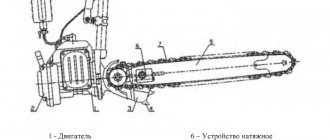Preparation of the fuel mixture when working with the MP-5 "Ural-2T Electron"
During the running-in period of the chainsaw, use a fuel mixture of gasoline and oil according to 2.3 in a ratio of 15:1 by volume, i.e. add 1 liter of oil to 15 liters of gasoline and mix the mixture thoroughly. The amount of gasoline and oil in the fuel mixture is given in Table 1.
Hello! I am glad to see you again, dear readers and subscribers of Andrey Noak’s Blog. Anyone who has a chainsaw at home already knows exactly what kind of gasoline and how to fill it. But anyone who just wants to buy such a unit will find the article interesting.
A chainsaw is one of the most convenient and versatile household units. Before use, you need to prepare the fuel mixture. But in order for the unit to work correctly, you must follow all the manufacturer’s recommendations. Each model is individual, so what kind of gasoline should you put in your chainsaw?
Chainsaw device
Each chainsaw has different technical specifications and can perform different jobs.
Powerful saws are suitable for felling centuries-old trees; small chainsaws are more suitable for performing various tasks in the household:
Standard chainsaw blocks:
- Power point.
- Clutch.
- Ignition unit.
- Carburetor.
- Fuel block (tank for oil and fuel).
- Filters for cleaning incoming air.
- Starter.
- Chain.
- Tire.
- Chain brake.
- Tension mechanism.
- Element that provides chain lubrication.
Each chainsaw requires high-quality fuels and lubricants; they ensure long-term productive operation of the unit. What kind of gasoline should I fill in for a chainsaw, in what proportions?
For domestic chainsaws, simple oils are suitable; foreign chainsaws need more complex fuel mixtures that have been thoroughly cleaned.
What oil should I use for a chainsaw chain?
To find out exactly what oil to use to lubricate the chainsaw chain, you will need to study the instructions of its manufacturer. Almost all tool manufacturing companies recommend using a product that has the highest adhesive properties. This means that the material used to lubricate the chain must have adhesion to the metal surfaces of the chain and bar.
You need to figure out why a lubricant has adhesive properties. While the chain moves along the standard guide bar, the saw element reaches high speed. If you use chainsaw oil with low adhesion for lubrication, then more than half of the liquid will fly off from the top of the tire by inertia, never reaching its bottom. As a result, such oil will prove to be ineffective, and the tire and chain will quickly fail due to constant friction.
Fuel selection
Which fuel to choose for a chainsaw is not an idle question; the success of the unit’s operation directly depends on it. According to existing canons, good gasoline for a chainsaw is considered to be not leaded, but high-octane from a trusted manufacturer. The cleaner the fuel, the better. If gasoline has been stored in a canister for a year and a half, this will negatively affect the operation of the device, so the substance should be prepared just before starting work.
It is important to ensure that the fuel does not contain alcohol or any additives that could interfere with the functioning of the power plant. Experts are still debating whether 95 or 92 is better. The first has more stable detonation indicators, but most often they still use 92. The reason is simple: questions often arise about the 95, it contains a large number of different additives that have a bad effect on the operation of the saw engine. Microdetonation occurs (piston impulse in the opposite direction), which occurs at almost every revolution of the crankshaft. If the octane number is even higher (98), then the micro-shocks will become even more intense.
The consequences of incorrect gasoline on the quality of operation of the unit can only be negative:
- The mechanism will be difficult to start.
- The power will be minimal.
- Parts will wear out more intensively.
Is it possible to fill 92 gasoline instead of 80 into a walk-behind tractor?
In order to answer this question correctly, you need to understand what is behind the labeling of these types of fuel. Well-known brands of gasoline - AI-76, AI-80, AI-92, which are classified by octane number, are characterized by nothing more than the ability of the fuel to detonate during compression, which is expressed in the amount of anti-knock additives. However, their calorie content is almost the same.
In practice, at low compression forces the 92 will detonate faster than its low octane counterparts. What does this mean? It all depends on the type of engine that is installed on the walk-behind tractor.
In particular:
- for 2-stroke engines - a decrease in power indicators, increased heat transfer, which can lead to overheating and failure;
- for 4-stroke engines - in addition to the above, there is also the likelihood of exhaust valve combustion and frequent stalls both at idle and under load.
In both cases, another phenomenon cannot be excluded - the so-called. "glow ignition" Glow ignition is a process in which the ignition of gasoline with air occurs not from a spark formed, but from overheated internal components or carbon deposits. Since 92 gasoline requires a higher calorific value and contains more cycloalkenes - carbon derivatives, when it gets into the engine, it contributes to overheating of mechanisms that can ignite the combustible mixture even without spark supply.
Despite the carelessness of the majority of consumers who confidently fill their cultivators with 92 or even 95 gasoline, this is highly not recommended. But this is not a sentence. For walk-behind tractors produced 15-20 years ago, which are designed to work with 76 or 80 octane gasoline, there are several ways out of this situation:
- mill the cylinder head, thereby affecting the size of the combustion chamber;
- shift the ignition angle so that the process of ignition of the combustible mixture does not occur immediately when the exhaust valve opens;
- install additional gaskets on the cylinder head;
- lower the octane number of 92 fuel.
How much oil should be added to gasoline?
Types of oils used for dilution in gasoline
Chainsaws do not have oil pumps, so the combustible mixture alone cannot be used. You should carefully read the instructions supplied by the manufacturer with each product. There is a lot of information on the Internet, finding it is not difficult.
If there is no lubrication, the saw will fail in a short time. It is recommended to do preventive maintenance of the unit, fill with properly diluted fuel, in this case the tool will function for many years.
If we take, for example, a Husqvarna chainsaw, then unleaded gasoline with the first additive of grade 92 is suitable. If the composition has a greenish color, then this indicates that the product is “Premium”. AI-92 is the optimal product that can be suitable for such a device. On average, professionals advise adding from twenty to 50 ml of machine oil per liter. If the power of the unit is one and a half kilowatts, then only 25-27 ml of oil will be required.
How to dilute engine oil and gasoline, in what proportions? This question arises for all users. First you need to stock up on containers:
- Measuring liter bottle
- A watering can that will allow you to pour the substance into the tank
The process of mixing oil and gasoline is technologically simple. It is important to follow safety precautions so that static electricity does not accumulate and not a drop of water gets into the fuel.
Types of oils used for dilution in gasoline
What proportions should be made? Engines are mostly two-stroke, so the mixture is usually 1:50. Russian-made chainsaws operate with products of the following brands:
For foreign analogues, it is permissible to use two liters of gasoline per 80 grams of oil. Foreign saws are characterized by economical fuel consumption; the proportions of oil in them vary from 40 to 49 parts.
Oil shades can vary significantly; this should be taken into account during operation. For example, it produces reddish-colored machine oil. If the composition has a greenish (sometimes blue) tint, then this is a sure sign that the product is premium synthetic. The quality of such compositions is high, and the cost is also quite high.
In what proportions should the liquids be mixed?
The proportions of gasoline-oil consistency for each brand of saw are determined by the manufacturer. How to dilute gasoline for (Ural, friendship, what oil to use for a chainsaw, how to dilute gasoline for a chainsaw? Gasoline with a high octane number is used as fuel for a chainsaw: ai-92 or ai-95. The more common proportion is 1:50, the best for saws with a power above 1.5 kW. But some manufacturers may focus on other proportions: Chinese - 1:25, Partner - 1:40. For chainsaws with a power of less than 1.5 kW, Stihl and Husqvarna companies recommend a ratio of 25 ml of oil per 1 liter of gasoline .
It is very important to maintain the required ratio correctly, because if there is a lack of oil, friction surfaces are likely to jam and wear of the bearings is accelerated. At the same time, excess oil leads to a reduction in engine life due to increased shock loads on the cylinder-piston group and carbon formation.
It is best to prepare the gasoline-oil mixture just before use and immediately refuel the chainsaw, and you should not leave the unburned mixture in the tank for more than a few days. This is due to the fact that oil additives are destroyed during storage. Therefore, it is better to drain the mixture from the tank, and then use the remaining gasoline at idle. To produce the consistency, you can purchase a special canister with separate holes for gasoline and oil. You should pour the ingredients into the proper holes and later connect them by tilting the canister. It is better to start with oil and then dilute it with gasoline. You can use a plastic or glass bottle, but with all this there is a danger of static voltage, which can lead to an explosion.
A plastic bottle is also unsafe because it can bend spontaneously, which will lead to the mixture getting on the saw and the skin of your hands. How to dilute gasoline, what chainsaw oil to use. It is unacceptable for water or small particles to get into the mixture. The container for mixing fuel must be thoroughly rinsed and completely dried before starting work. To dilute the mixture correctly, the bottle should be graduated. For example, for a consistency of 1:50, you need to put marks on the bottle corresponding to the amount of water that is a multiple of 51. “How to properly dilute gasoline for a chainsaw, how much oil is in gasoline. Water can be used as measuring water. Then for mark 204 you will need to dilute 4 ml of oil with 200 ml of gasoline. Gasoline for a chainsaw for a chainsaw: how does a chainsaw work? Stihl canister with. In order to add ingredients to the measure, you can use a plastic syringe, but without a needle. Measuring containers should be stored loosely closed. Both the measure and the syringe should be protected from dust.
A chainsaw can become your assistant for many years to come if you handle it carefully and carefully
Video instruction: How to properly dilute gasoline with oil for a chainsaw
Mineral oils are inexpensive, so they are most often used. Synthetic oils must be filled in if there are significant temperature fluctuations; they do not generate carbon deposits and have additives that are useful for dynamic components.
The product is considered the highest quality, with Lukoil machine oil in second place.
Advantages of these oils:
- Insignificant consumption.
- Maintaining quality.
- The ability to maintain technological qualities for a long time.
- Can work in extreme conditions.
- No toxins.
- Minimum amount of soot.
Many professional tools use lubricant made using API-TB technology (USA). Products that are produced using the JASO-FB method (Japan) are also popular.
It is acceptable to mix oils from different branded manufacturers with similar characteristics. Mineral and synthetic oils are incompatible with each other. The best oil for household chainsaws is considered “Standard”; for professional equipment, “Ultra” technical fluid is optimal.
Main features of the Ural chainsaw
The Ural chainsaw appeared in 1935. Since then, it has become widespread in the USSR, and after its collapse - in the CIS countries. Subsequently, the manufacturer made a number of improvements to the design of this tool. The new model, made of high-strength materials, is called the Ural-2T-Electron chainsaw. It is designed for use in harsh conditions in any season of the year at extremely low and high temperatures. Using a Ural chainsaw, large trees are felled and sawed. It consists of the following main nodes:
- motor;
- clutch;
- saw unit;
- frame with handles;
- engine starting system.
The tool is mobile and standalone. Although it is equipped with a vibration damping system, the vibration during operation of the chain saw is still high. For this reason, forest fellers are instructed to use the Ural chainsaw no longer than one and a half hours a day. This measure helps prevent the development of occupational diseases caused by harmful working conditions.
In addition, this device is inferior to imported equipment in the following respects:
- the Ural chainsaw engine operates with increased gas generation, so that the operator is forced to remain in a gas-filled environment for a long time;
- servicing the device requires experience and skill;
- there is no chain brake;
- the device uses a mixture enriched with oil twice as strong as compared to foreign gas-powered tools;
- increased fuel consumption.
At the same time, the Ural chainsaw has a number of advantages that allow it to compete with imported models:
- reliability;
- the ability to easily carry out both longitudinal and cross cuts;
- high handles allowing you to work at full height without bending over;
- low cost.
Advantages and disadvantages of oil
Any high-quality machine oil has its pros and cons.
Any high-quality engine oil has its pros and cons . Some experts say that any chainsaw oil will do. This is not entirely true; almost any substance can be used for the Khurstavna chainsaw, but only gear oil is required for the Shtil chainsaw. When choosing, you need to know the color of the oil well; a two-stroke engine requires a composition that has a reddish, bluish or greenish tint.
To prepare the mixture yourself, you need to use a heat-resistant lubricant that has a well-known brand.
The density of the product is affected by seasonality:
- Solar radiation intensity.
- Pressure.
what the features of different oils are by carefully studying the label on the container. If there are no instructions or labels on the package, you should refuse to use such a substance. At the same time, the performance characteristics of oils should not change dramatically when temperature conditions change.
You should not use any substitutes; counterfeit products are often found among them (up to 20%). It is quite difficult to distinguish a fake; you need special equipment.
It is recommended to store fuel in metal containers. It is best to prepare the fuel mixture in a canister.
There are a large number of oils and each has its own characteristics
The consistency is made in the ratio:
The performance characteristics of mineral or organic oil intended for the chain itself are not suitable for preparing the fuel mixture. The container is filled with the finished product (up to half), then mixed (the container must be hermetically sealed). Thus, a homogeneous composition is obtained. It is better not to prepare the fuel ahead of time; it quickly loses its functional properties. At room temperature, flammable liquids deteriorate within two weeks.
The best oils for chainsaw chains
You can find the highest quality oils on the market, which are recommended to be used by almost all manufacturers of chainsaws and companies that manufacture saw accessories for them. These products have high adhesive properties, which makes them effective when working in difficult weather conditions. These lubricants include:
- Stihl ForestPlus oil - this composition is best used at an air temperature of at least -15 ⁰ͦC. The material is supplied for sale in containers with a capacity of 1 or 5 liters;
- Stihl SynthPlus lubricant - has high adhesion to metal coatings. The composition shows high efficiency when working in conditions not lower than -25 ⁰C;
- Husqvarna Bio Advanced oil performs equally well in both normal and extreme conditions. The product has a balanced composition with increased adhesive properties;
- Makita Biotop lubricant is one of the top products. reliably protecting the sawing parts of the tool from increased friction and premature wear. The price of this oil is an order of magnitude lower than Stihl products;
- Oleo-Mac Polar Lube oil is a budget lubricant that stands out for its low price and excellent viscosity and adhesion parameters.
To lubricate each of these products, manufacturers advise using no more than 5 mg of lubricant per cycle of operation.
Adviсe
Tips and life hacks can be extremely useful in practical work, let's look at some of them:
- It is convenient to use cans with dispensers, and experienced people filter gasoline through suede. The cleaner the fuel, the better the carburetor will work.
- Gasoline can actively evaporate, especially at high temperatures; a suspension forms at the bottom of the canister, which cannot be poured into the engine.
- It is recommended to prepare fuel for no more than three operational refuelings.
- The quality of the fuel can be affected by the material of the container; PVC materials react especially actively.
- If the combustible mixture was poured of poor quality, the chainsaw may be void of warranty.
- During operation, you should test the tightness of the containers and the rhythmic operation of the engine.
- One of the first signs of a malfunction is undue heating of the circuit.
- Before subjecting the tool to serious loads, you should test it at idle speed.
- The tank lasts for half an hour when working.
- There is still lubricant (residues) in the second container when the reservoir runs out.
- If a large amount of smoke appears during operation, this means that the fuel is of poor quality.
- While the unit is operating, do not approach open flames.
- (distance up to 2 meters).
- You should not fill the fuel “under the rim”; leave a little space.
Ignition timing adjustment method
Before converting a walk-behind tractor engine from 80 to 92 gasoline, you will need to replace spark plug A 11-3 with spark plug A17B. After this, you can begin to adjust the advance angle to move it no more than 2 degrees counterclockwise. The work algorithm looks like this:
After completing these procedures, you need to assemble the engine. During assembly, make sure there is a key on the end of the crankshaft. Tighten the flywheel mounting nut to a torque of 16 kgf/m and secure with a lock washer. While doing this, work with the part that is not jammed. After the modification, you can confidently fill the tank of your walk-behind tractor with 92 gasoline - the unit will work like clockwork.
Ratio of oil and gasoline for the fuel mixture
The proportion of oil and gasoline for a chainsaw is usually made according to two recipes:
- 50 servings of gasoline per serving of motor oil
- 40 units of gasoline per unit of motor oil
If the chainsaw was recently purchased and has not yet been used, then the proportion of lubricant is increased by a quarter. The same amount of it is poured into fuel when sawing at temperatures below +2 degrees . It is not difficult to obtain such a mixture. Almost every modern saw is equipped with a special two-section container. Oil is poured into the smaller part, and gasoline into the larger part. The lids of both parts are screwed tightly and the container is turned over and shaken thoroughly. This ensures complete and homogeneous mixing of both components.
If there is no such special container, then you can use any gasoline-resistant plastic container with a one-liter lid and a disposable syringe for 5-10 cubes . The gasoline container must first be cleaned of various types of contaminants and water. After this, one liter of 92-95 gasoline is poured into it.
20 ml
is drawn into the syringe . If refilling is done in cold weather, then you need to take 24-30 ml . Carefully pour it into the container with gasoline. It is tightly closed with a lid and shaken thoroughly until the components are completely mixed.
How to measure head temperature and exhaust gas temperature?
Here's what it might look like:
We will obviously measure with thermocouples. Two. One of which should be present inside the muffler, and the other should be pressed against the cylinder head at the point that is most likely to have the highest temperature among other places in the head.
The thermocouple wires are connected to a twisted pair (gray wire in the pictures; twisted pairs are used to connect computers to each other, as well as to modems, printers, etc.), and this, in turn, is connected to two digital multimeters.
To ensure reliable measurements, a hole was drilled in the muffler for a thermocouple - an exhaust gas temperature sensor - to measure the temperature of the gases directly leaving the engine cylinder, and not the gases that passed through the muffler system and were partially cooled.
And now - bigger:
The spark plug of the tested Ural chainsaw was, generally speaking, a terrible sight:
Overgrown with soot, which apparently included oil additives. Hmmm... Nevertheless, the saw did its job quite well, i.e. sawed. It started with 1…4 jerks (more on this below). The spark plug was not specifically changed in order to test the ability to start the engine and operate the chainsaw in slightly worse technical conditions.
Experimental results
Now, finally, let's look at the most interesting thing - the experimental results. The Ural chainsaw was tested when sawing wood (with a diameter of 10 to 30 cm and, sometimes, more), the following mixtures served as fuel:
Before the next test, the remaining fuel was carefully drained from the gas tank, after which a mixture with a new composition was poured in and the tests continued. The tests were carried out in the sequence listed above. In total, the tests took about three days during the period July 5...15, 2022. The oil was used like this, which stood in a plastic container for about 1.5 years.
Diesel fuel was purchased at the Bashneft gas station in July 2019.
results
What happened? To be honest, it was expected that mixtures using 92-octane gasoline would show themselves to be much more “high-temperature” compared to 80-octane. But, strangely enough, nothing like that happened. The saw cut quite tolerably on all of the specified mixtures. It was not possible to record any significant increases in temperature.
The table below shows the results of the experiments:
Recommended brands of fuels and lubricants for powering chainsaws
The specific brand of gasoline for the saw is always given in the manufacturer's instructions. It is recommended to strictly follow it.
There are 2 types of oil:
- for the engine,
- for lubricating the chain and bar.
Do not confuse or misuse them. This is guaranteed to lead to tool failure. Repairing it can cost almost the same as a new saw.
The most popular lubricating oils for chainsaws are the following brands:
Each container with branded oil always indicates the proportion of oil and gasoline for a chainsaw (Stil, Husqvarna, Partner, Ural), which must be adhered to when composing the mixture.
Technical characteristics of the Ural tool
A qualitative indicator of the Ural brand is a powerful and economical two-stroke gasoline engine. Ease of use and lightweight design make it indispensable in such work as building a wooden house, sawmill, logging, and household preparations for the local area. Let's look at the characteristics of the Ural chainsaw with a detailed description of the advantages of the tool.
Gas engine
Designed for professional purposes, the Ural 2 Electron chainsaw has the following engine characteristics:
- Power 5 l. With.
- Single cylinder
- Piston diameter - 5.5 cm, cylinder volume - 109 cubic meters. cm.
- Push-pull
- Gasoline consumption at maximum power is 0.63 liters, at working power – 0.47 liters.
- The crankshaft operating cycle frequency is 2600 rpm.
The two-stroke engine is powerful and reliable enough to quickly chop wood within 11 cubic meters. in a minute.
Cylinder
To improve wear resistance, the aluminum cylinder is coated with a silicon-nickel alloy called Nicosil. Cylinder volume 109 cc. cm provides sufficient power for a chainsaw. The cylinder has an inlet channel for the gasoline-gas mixture, exhaust channels and purge channels. The execution of certain proportions of the sizes of the exhaust and purge holes ensures high-quality ventilation of the cylinder cavity from exhaust gases.
Gas tank
The volume of the fuel tank is 1.6 l, and for oil - 0.24 l.
To increase the durability of the engine, you should use the grades of gasoline specified by the manufacturer in the passport. In a two-stroke engine, it is worth using special grades of oils that combine well with gasoline and do not leave a large sediment when burned in the chamber.
The gas tank is filled with a mixture of AI-72 gasoline and M-8B engine oil. The lubricant tank is filled with oil in summer, and in winter - with the addition of gasoline in a ratio of 3/1.
Carburetor
A carburetor is necessary to create an air-fuel mixture of a adjusted proportion, entering the cylinder in certain doses. The tool uses a modification of the KMP-100U carburetor. It must be adjusted at the factory, but you can independently adjust the unit in various operating modes to obtain maximum engine efficiency.
Before first use, it is recommended to keep the tool for several hours with a tank filled with fuel to saturate the carburetor membrane.
Bar length and chain
The length of the working surface of the saw is 46 cm. A cutting chain is placed on it, which requires periodic sharpening and tension.
Advice: during prolonged downtime of the tool, it is better to remove the cutting chain, and it is more convenient to sharpen it on a chain put on the saw.
The weight of the assembled chainsaw is about 12 kg.
Step-by-step instructions for refueling
If you want to refuel your chainsaw, you need to follow a simple algorithm:
- Prepare fuel in the recommended proportion of gasoline and oil for two-stroke chainsaws.
- Prepare the saw for refueling by clearing its surface of sawdust and shavings.
- Place the saw on a flat, stable stand with the reservoir neck facing up.
- Carefully place a small funnel (plastic or metal, resistant to fuels and lubricants, easily purchased at an auto supply store) into the open neck of the tank.
- Carefully pour fuel into the tank, avoiding overflow. It is unacceptable to pour under the lid - this will lead to splashing out while screwing the lid!
- Close the lid of the fuel tank
- Replace chain lube (required!)
- Test run the engine at idle speed.
Oil for two-stroke chainsaw engines
Modern gasoline saws can be equipped with 2-stroke or 4-stroke engines. In the latter, oil is initially supplied to the crank group parts directly from the engine crankcase.
In contrast, in two-stroke factory engines, fuel enters a plane located under the piston. To refuel such chainsaws, you need to add motor oil to fresh gasoline. It lubricates the rubbing parts of the engine, preventing their premature wear.
Oil for 2-stroke chainsaw engines must meet a number of important parameters:
- When burning oil, a minimum amount of ash should be formed. It is best to allow the oil used to burn completely;
- the lubricant must dissolve quickly in gasoline;
- Oil for 2-stroke engines must be free of harmful impurities that can lead to blockages in the carburetor lines.
What happens if you pour waste into a chainsaw?
Once a chainsaw owner has been using it for a while, he may want to make some modifications to the tool. And it’s good if his desires are limited to purchasing various attachments that expand the functionality of the chainsaw. But some go further - they begin to experiment with the gasoline and oil that their saw runs on.
If we already talked about gasoline earlier (most modern saws require it with a high octane number - no lower than 92-95), then it’s worth special mention about oil. Many car enthusiasts accumulate a significant amount of used engine oil during the operation of their car. And that’s why some people want to use this material to refuel a chainsaw.
If you do this, then engine failure is guaranteed. The reason for this will primarily be the low lubricity of the reused oil. It will burn with a lot of black soot. The metal particles contained in the oil will first clog the fuel filter (these are the larger particles), and then the cylinder sealing rings will fail. Metal suspension in oil will damage both the surface of the cylinders themselves and the bearings.
Some “innovators” are trying to use oil to lubricate the chain itself and the block on which it is located. This will also not lead to anything good. What exactly will happen can be seen in the attached video.
Under the brand
For modern brands, for example, Husqvarna, Partner, Makita, Echo, Shtil, AI-92 gasoline is suitable. Today, a huge number of people complain about premature failure of chainsaws due to bad gasoline. Therefore, some experts recommend pouring AI-95 into such chainsaws. At the same time, good AI-95 can “burn the piston,” and again, a number of people have found a compromise and mix AI-95 with AI-92. In general, it all depends on the quality of gasoline and ultimately it’s up to you to decide.
For domestic instruments, Ural, Druzhba, it is recommended to take AI-80 gasoline. It is very important that fuel consumption is minimal.
Preparing the fuel mixture for a chainsaw
Let's look at everything in order:
Petrol
Gasoline must have an octane number of at least AI92. You can also fill in AI95, but its quality at our gas stations leaves much to be desired, so if you are not sure of the quality of 95, then it is still better to take AI92 gasoline for diluting gasoline in a chainsaw. You should also not take gasoline that has been sitting for a long time in a canister, tank or any other container. Gasoline for preparing the fuel mixture for a chainsaw must be fresh, otherwise it loses its properties, in particular its octane number, and even if you run the chainsaw on such fuel, it will not produce full power. And the saddest thing in this case is that the failure of a chainsaw due to low-quality fuel is considered a non-warranty case and leads to expensive repairs. Sometimes it’s easier to buy a new chainsaw than to repair it after such a breakdown!
Read more about gasoline for chainsaws here:
Oil
Oil for 2-stroke engines according to the classification of the American Petroleum Institute (API), the American Petroleum Institute has the API-TB class, there are also API-TC class oils, but they are designed to work with lower loads than most common chainsaws. If you take the power class according to the Japan Automobile Standards Organization (JASO) classification, then focus on the JASO-FB and JASO FD classes (see Table 1 below.). Do not under any circumstances use oils for four-stroke engines! Remember that in a two-stroke engine the oil must burn completely, which means it is better to take synthetic oil, since it produces less smoke and combustion residues. And if you fill your chainsaw with oil for four-stroke engines, which will not burn completely and as a result carbon deposits will form, then your CPG will fail. The best thing to guide you when choosing oil for a chainsaw is the instructions for it.
Proportions
When preparing a fuel mixture of gasoline and chainsaw oil, be sure to check the manufacturer's recommendations. Why is it so important to follow these recommended proportions? If the amount of oil in gasoline is small, the cylinder and piston will heat up and, accordingly, scuffing will occur, which means failure of the CPG and repair. If there is a lot of oil in gasoline, then this is carbon deposits and again failure. Each manufacturer has its own recommendations on proportions (see Table 2 below). Try not to store the finished mixture for more than a month. Do not store it in direct sunlight or open. Avoid ingress of water and dust - this will lead to carburetor failure, since the fuel filter is often not able to completely clean the fuel.
Since they often come from search engines with queries like “how much oil to pour into 1,2,5 liters of gasoline,” I’m adding another table under No. 3 in which you can find out how much oil to add to gasoline according to the accepted proportions. The proportions can be found in Table 2 or, more precisely, in the instructions for your chainsaw.
Devices for diluting the fuel mixture
Of course, you can use a canister, syringe or measuring bottle, but there are more convenient options. It is worth noting here that, for example, Stihl oils are available in 2 types of packaging - with and without a dispenser. With a small difference in price, a bottle with a dispenser greatly simplifies the process of preparing the mixture. There are also many different canisters with a dispenser, with separate compartments for oil and gasoline. All these devices reduce the preparation time for starting and operating the chainsaw.
Chainsaw repair Ural 2
Any tool can fail over time. This is an indisputable fact. It should, however, be noted that repairing the Ural 2 electron chainsaw mainly comes down to working with the engine. Such units in the saw can stall under a certain load, hold idle speed poorly, and so on.
The reason the saw stops working immediately after it starts may be a faulty carburetor. It will have to adjust the jets in order to receive the appropriate fuel supply.
When a heated engine stalls, most likely you will have to change the pistons, spark plugs, or clean the air filter. It must be said that a fully serviceable motor in a saw simply must work without jerking. If a ringing knock is heard during its operation, this may indicate a malfunctioning cylinder.
Video: carburetor adjustment
The Ural 2 Electron chainsaw has long established itself as an excellent workhorse, with high performance, ease of repair and reasonable cost. Almost the only thing that can happen to this tool during proper operation is that the carburetor settings are lost.
Chainsaw sprocket oil - manufacturer's advice
In order to reduce friction on the drive sprocket and extend the service life of the mechanism, each manufacturer equips it with a needle bearing that requires periodic lubrication. Many experts advise using a multi-purpose composition from the Stihl brand for this.
This product is quite expensive, so some gardeners and professional forest fellers use lubricants at a lower cost. Compositions such as Litol or Litol 24 have proven to be effective against increased friction of a needle bearing.
To lubricate the driven chainsaw sprocket, as well as to protect the drive sprocket, you can use the same oils. A small syringe is suitable for applying them. It quickly presses lubricant into small holes in the tire and near the bearing located above the sprocket.
vote
Article rating











